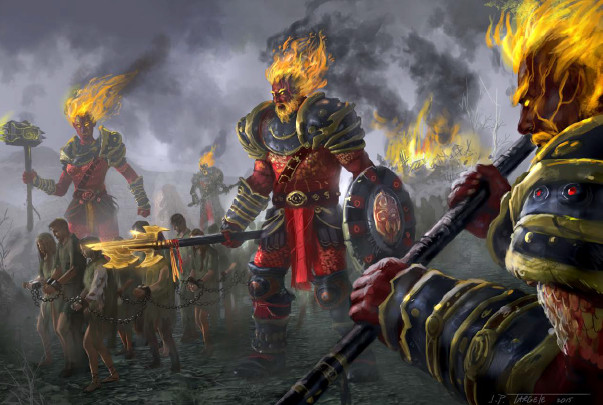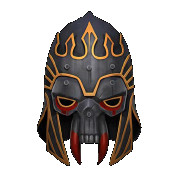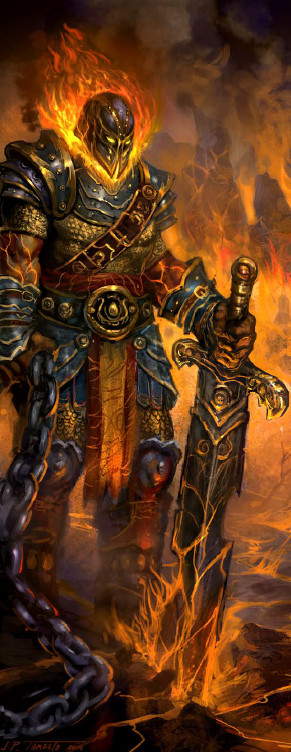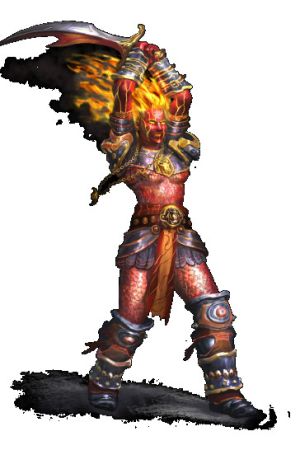Zursvaater

Zursvaater
- A ccording to fire giant legends, over 10,000 years ago, the mightiest volcano sensed the presence of stone giants climbing on his surface and sculpted his body into a towering, humanoid shape to speak with them. Calling himself Zursvaater, he offered the giant tribe the secrets of metal and volcanic fire in exchange for their worship and souls. They accepted his deal, and Zursvaater enveloped them in his molten body, expelling them as lesser imitations of his own form. This new race—the fire giants—became notorious for their metal crafting, raids, and slave-taking as they obeyed their god’s directive to bring the world under the dominion of his chosen people. Zursvaater’s plan will take many centuries to come to fruition, but like lava creeping out of a volcano to cover the nearby land, the martial tide of the fire giants gradually envelops and destroys all those who dare to stand in its way
Acreature of ash, molten rock, and red-hot metal, Zursvaater [zurs-VAH-ter] is terrible to behold when angered, but he always focuses his destructive outbursts on something other than his own minions or worshipers. Despite his explosive temper, Zursvaater is a crafty, patient, and tactically brilliant ruler focused on conquest and domination. His rigidly enforced hierarchy places mortal rulers at the heads of his followers’ communities, and demands that each rank submit completely to the ones above.
| Zursvaater | |
|---|---|

| |
| (Déité) | |
| Titres | Prince of Steel |
| Home | Hyrrfellhame, Hell |
| Alignement | Lawful evil |
| Portfolio | Conquest Slavery Weapons |
| Adorateurs | Fire giants; slag giants |
| Cleric Alignments | Modèle:Alignment grid |
| Domaines | Evil, Fire, Law, Trickery, War |
| Sous domaines | Ash, Blood, Slavery, Tyranny |
| Arme de prédiléction | Greatsword |
Fire giant generals and master smiths hold honored positions in his societies, as their labors contribute most directly to their god’s plans. Fire giant settlements range in size from small tribes to the mighty kingdom of Kerdreg in southern Thuvia, but regardless of a settlement’s size, Zursvaater’s hierarchy informs every aspect of its citizens lives.
Also known as the Prince of Steel, Zursvaater loves his worshipers as a miser loves gold. Having crafted the fire giant race out of “lesser” beings, he sees any fire giant who turns to other gods as an affront to his role as a creator and parent. He loathes risking his faithful, but knows it is sometimes necessary to make sacrifices to achieve greater rewards, encouraging his people to conquer other races using clever tactical strikes that seize many slaves without wasting valuable resources. His direct communication with his worshipers is infrequent but detailed, as he does not feel the need to update them or explain his plans unless it is necessary for them to competently execute his orders. He views those who disobey as weak, cowardly, and unworthy of being fire giants, and condemns them to toil like beasts or slaves.

Zursvaater teaches that the strong should rule the weak, that slavery is little better than death, and that the strong should be prepared for all-out war at any time lest the weak catch them off-guard. It is proper to aspire to a higher position, and it is expected that exceptional or skilled individuals will rise through the ranks and perhaps marry into the fire giant nobility. The Prince of Steel strongly discourages infighting among fire giants, and has been known to curse royalty and nobility who instigate such conf licts, or even relocate entire fire giant fortresses to end bloody feuding. The faithful are loyal to their leaders and other members of the faith; disputes between individuals too great to be ignored or soothed with wergild are usually settled with duels or through elaborate war games using toys, slaves, or proxy allies.
The Prince of Steel rarely bothers to reward or punish followers directly; instead, when an individual needs to be lauded or reprimanded, he is more likely to send a vision to a higher-ranked fire giant and let the chain of command do its work. As the creator of the fire giant race, he can withdraw his gift of fire immunity from any fire giant at any time, or fill an offender with the pain of being burned alive. When he is unexpectedly pleased by a fire giant’s work or achievement, he makes his unholy symbol appear as a splash of molten iron that quickly solidifies. The fortunate few fire giants who receive signs of their god’s favor wear them like high military decorations and pass them down to their children.
Zursvaater considers himself a practical god, and does not require praise from his followers—only obedience. He loves military tactics and enjoys debating strategies with his trusted minions and the servants he crafts from the souls of his most skilled fire giant generals after their lives come to an end.
Zursvaater is lawful evil. His portfolio is conquest, slavery, and weapons, and his domains are Evil, Fire, Law, Trickery, and War. His favored weapon is the greatsword, and his unholy symbol is a helm with fangs. He teaches his followers that trickery is a valuable tool to use on lesser beings, but that within their own hierarchy it is inefficient at best, and a sign of disrespect toward authority at worst. Most of his worshipers are fire giants, but there are a few slag giant tribes who acknowledge him as their maker. Most of his priests are clerics, although a few inquisitors and oracles of f lame pay him homage. His faith is concentrated in the mountainous areas that are the favored home of fire giants.
Sculptures of Zursvaater depict him as a mighty, armored fire giant with a closed-faced helm, sometimes holding a heavy chain in one hand. When manifesting to his followers, he has a visible aura of heat and f lame, and his every breath creates a cloud of volcanic ash. His skin has a red hue that more closely resembles a fiend’s skin tone than it does lava or fire, but in battle, his f lesh turns to molten stone and burns any who touch him. His adamantine greatsword Blood of the Mountain glows hot enough to melt most metals, and cuts cleanly through armor. The god keeps his divine realm of Hyrrfellhame, an immense underground cavern containing three active volcanoes, hidden in Hell. Fiendish fire giants, armored creatures resembling shifting infernos, and hordes of burning skeletons guard the entrance to his stronghold.
Worship services combine shouting and chanting choirs, gongs, bells, heavy steel drums, and f lames.
Sacrifices are usually in the form of food, animals, and unruly slaves who are burned or thrown into lava f lows.
Valuable items, such as jewelry and equipment, are never discarded this way unless they can’t be used by the faithful.
Zursvaater’s church strongly encourages marriage, seeing such bonds as supporting the community’s stability and order. An unmarried clan leader usually entertains many suitors from other settlements, though such marriages are often made only for political purposes, and both spouses may take other lovers. Some princes and princesses are half-fiendish fire giants, usually born to the reigning fire giant queen with her spouse’s knowledge and proclaimed approval. Newborns with twisted spines, strangely shaped limbs, or other features that many races would consider deformities are auspicious signs of divine favor. Such variations rarely compromise the giants’ strength; they instead encourage foolish opponents to underestimate them in battle.
TEMPLES AND SHRINES
Zursvaater’s churches are usually built in stone caves, preferably with glowing lava or large braziers or pots of oil that can be set alight at each service. The walls are carved to look like a ring of active volcanoes that surrounds the central hall and are painted to reinforce this mountain imagery. False caves are carved into this facade at ground level to store weapons and throwing rocks in case the temple is attacked. In an outdoor temple, the altar is usually covered with a sturdy canopy of hammered metal scales to shelter it from the weather.
Shrines to the Prince of Steel usually consist of a large piece of volcanic stone carved to resemble a fanged helmet.
Many temples keep their greatest treasures in a secret metal box hidden within the helm, trapped with razorsharp blades to protect its contents from unworthy hands.
A PRIEST’S ROLE

Zursvaater’s priests are a force of order, reminding their followers of the necessity of obedience, punishing slaves, and extracting information from prisoners. They are often members of the nobility, and it is common for a clan’s king or queen to be a priest or have a sibling in the priesthood.
Priests arrange diplomatic events between allied tribes, negotiate surrender terms for lesser creatures defeated on the battlefield, and perform marriages for all social classes in the tribe. Many priests have some skill at Craft (armor or weapons), Diplomacy, Intimidate, Knowledge (nobility), and Sense Motive.
A typical day for a priest begins with prayer and a “baptism of fire” in which the priest places one or both hands in a fire, on a forge, or in lava to demonstrate that the god hasn’t withdrawn the priest’s protection against fire.
This is followed by a meal, after which the priest reports to a superior for orders or carries out existing orders if no superior is present. A priest with underlings issues orders to them after receiving his own. Divine spellcasters usually prepare their spells after evening prayer.
Meetings between two fire giant settlements usually begin with a parley between priests, who discuss their accomplishments and determine which tribe’s high priest has a higher rank.
Priests usually let their hair grow long, but tie or braid it neatly, and male priests groom their beards in a similar fashion. It is common for priests to tattoo their hands and around their eyes with fang-like markings using gold or copper to catch and accentuate firelight. They dress in black with orange accents and wear metal armor. Priests commonly don black tabards with fanged orange helms over their armor. They are fond of ornamenting their clothing with orange gems, such as citrine, fire opal, and zircon, or crafting these jewels into magic items.
HOLIDAYS
Zursvaater’s major holidays serve to enforce the hierarchical structures he imposes on fire giant society.
Night of the Inferno: This holiday, celebrated in Sarenith, commemorates Zursvaater’s creation of the fire giant race. Because the exact day that the first stone giants accepted Zursvaater’s blessing has been lost to history, each tribe and kingdom selects its own night to celebrate this momentous occasion. Celebrations involve lighting immense pyres and holding contests of speed, strength, and cleverness to demonstrate how the tribe’s power has grown since the previous year. The high priest of each tribe covers herself in stone armor and submerges herself entirely in lava, then bursts forth with the stone melted and stripped away.
Ruler’s Day: Each tribe celebrates Ruler’s Day on the day that their current monarchs began to rule the kingdom.
No tribe actually calls the holiday “Ruler’s Day”; rather, each tribe names the holiday after its own monarchs. On this day, the king and queen give speeches describing how the tribe has prospered under their rightful rule, and may use the occasion to promote the worthy or deliver orders to all members of the tribe at once. Afterward, the tribe indulges in a lavish feast prepared by slaves. Particularly troublesome slaves become part of the feast on this annual day of renewal.
APHORISMS
Most fire giant exclamations are battle cries, and a few stem directly from their faith.
Flesh and Souls for the Prince: This cry damns an opponent’s soul to the Prince of Steel to serve him as a slave forever in his volcanic realm.
He Gives Me Strength: Every fire giant alive owes its existence to the god’s original act of transformation. This maxim is a reminder that the speaker’s power is a gift from Zursvaater, and makes each successful attack or def lected blow a prayer of thanks to him. The faithful know that at any time their god might withdraw his blessing, and that they remain in his favor only so long as they are obedient to his will.
The World Shall Be His: The faithful envision a time when the entire world will fall under the Prince of Steel’s dominion. This exclamation serves as a threat to all who would oppose him and as validation to the faithful.
HOLY TEXT
Zursvaater’s faith is simple and direct, and its rules are traditionally inscribed on a steel plate, hence the title the Law of the Shield. The original plate is said to be a powerful artifact that Zursvaater inscribed with his own hand. As the Prince of Steel transformed more stone giant tribes into fire giants, his first priest copied the sacred text onto a more conventional shield for the tribe’s king and queen.
It is now a tradition that when a tribe grows too large for its home and some giants leave to found a new tribe, the high priest of the old tribe personally copies the text as a gift to the new tribe’s rulers.
The text itself describes the compact between Zursvaater and the giants who swear their souls to him, and details a few specific prayers, laws of obedience, proper sacrifices, and the god’s plans for conquest. Within those constraints, the giants have free reign to create their own tribal or religious laws. As a result, two distant fire giant settlements may have significantly different regional customs.
RELATIONS WITH OTHER RELIGIONS==
The secretive Prince of Steel shuns contact with most other divine beings, focusing his attention on events in the mortal world. Despite his relative reclusiveness, he holds strong opinions about several other deities, which some of his followers use as guides for their own interactions with servants of other patrons.
ZURSVAATER
Zursvaater has particular contempt for Thremyr, god of frost giants. Beyond the natural opposition of their elements, he finds Thremyr’s fits of rage, as well as his bloody and disorderly style of warfare, to be distasteful.
Similarly, he believes that Gorum’s pursuit of warfare for its own sake is senseless. He finds Minderhal amusing, believing that the stone giant deity is a pale imitation of his own majesty, much as stone giants themselves are merely the raw materials he used to forge his own followers. In the eyes of the Prince of Steel, Torag is a god of pests, whose defensive teachings have made the Father of Dwarvenkind’s followers troublesome to root out.
However, he grudgingly respects Torag’s skill as a smith, and encourages his followers to make use of dwarven weaponry and forge-slaves when they can.
NEW SPELL
Clerics of Zursvaater may prepare burning gazeAPG as a 2nd-level spell and wall of lavaAPG as an 8th-level spell.
His inquisitors may learn burning gaze as a 2nd-level spell.
Zursvaater’s priests have access to the following new spell.
STOKE THE INNER FIRE
School transmutation [fire];
Level cleric 2, inquisitor 2 (Zursvaater)
Casting Time 1 standard action
Components V
Range personal
Target you
Duration 1 round/level
You increase the natural heat within your body, transferring it to your weapons and armor. As a swift action, you may grant one of your natural or manufactured weapons the flaming special ability for 1 round. If you have the fire subtype, your weapon instead gains the flaming burst special ability. If the weapon leaves your hand for any reason, it loses the flaming (or flaming burst) special ability until you spend a swift action to activate it again. You can only have stoke the inner fire active on one weapon at a time, and spending a swift action to imbue a second weapon with the spell’s power immediately ends its effect on the first weapon.
The spell also builds a wall of searing heat between your armor and your flesh. Anyone striking you with a natural weapon or unarmed strike takes 1 point of fire damage. A creature that grapples you or is grappled by you takes 1 point of fire damage each round the grapple persists. If you have the fire subtype, these damage values increase to 1d6 points of fire damage each. Removing your armor causes this wall of heat to dissipate and ends these effects.
PLANAR ALLIES
Most divine servants of Zursvaater are either ascended fire giant souls or fiend-like giants.
Jarl Bellarn: This tall, proud fire giant waged war against frost giant clans in the name of her father, King Rolgar, even before she came of age. She personally slew the entire noble court of the frost tyrant Norfi before being felled by a poisoned spear, and is remembered as a great hero-warrior of the fire giants. Her very presence acts as a bardic performance to inspire courage, granting a +2 bonus to all fire and slag giants within 100 feet. She also has a +4 favored enemy bonus against frost giants, as the ranger ability. She appreciates offerings of poisonresisting items and the severed heads of frost giants, winter wolves, and white dragons.
Jorgaf, Heir to the Sixth Throne: This stout fire giant’s fiendish heritage is visible in his scaly skin, batlike wings, burning red eyes, poisonous fangs, and reptilian tail. His helm closely resembles Zursvaater’s holy symbol, and his armor is designed to f launt his fiendish traits. Despite being one of his god’s favored minions, he is sullen and gravely focused on carrying out his assigned task. He is ruthless in battle, striking fear into anyone within reach.
Restitution: This broad fire giant is nearly as wide as he is tall. “Restitution” is a title, and no mortal knows his real name. It is suspected that when he was a mortal giant, he killed a high-ranking member of his tribe, and that when he could not pay his victim’s family, he was executed and condemned to servitude in the afterlife for a thousand years.
Some fire giants suspect he was framed or accepted this burden to protect another giant. His battered armor covers his many scars, and though he is curtly polite, he turns away inquiries about his past with a cryptic answer: “My name belongs to the Prince, until nine and nine and nine are spent.” So long as he is properly compensated, he accepts all missions without complaint, even suicidal ones, as his divine master will revive him if necessary.
OBEDIENCE
The following describes the ritual a worshiper of Zursvaater must perform to take full advantage of the Deific Obedience feat found on page 210 of Pathfinder Campaign Setting: Inner Sea Gods, as well as the boons for the evangelist, exalted, and sentinel prestige classes in Inner Sea Gods.
Obedience Immerse yourself in lava or a roaring flame for one hour. During the first half hour, recite passages from the Law of the Shield and meditate upon how your god’s will guides your actions. Divide the remainder of the hour between recounting the orders and obligations that your superiors have given you, and planning the orders you will give your subordinates on the following day. You gain a +4 profane bonus on saving throws against spells and effects with the cold descriptor.
EVANGELIST BOONS 1: Slave-Taker’s Tools (Sp) command 3/day, stoke the inner fire* 2/day, or chain of perditionUC 1/day 2: Sense Slaves (Ex) You gain the scent ability, but only with respect to humanoids. You gain a +2 favored enemy bonus against humanoids, which stacks with any favored enemy bonus you already possess against humanoids.
3: Searing Strike (Su) Once per day, you can channel the Prince of Steel’s power through your weapon as a free action. You must declare your use of this ability before you make an attack roll. On a hit, the weapon creates a burst of fire. Your target takes 5d6 points of fire damage and catches on fire unless it succeeds at a Reflex save (DC 10 + 1/2 your HD + your Charisma modifier). If the target catches on fire, it takes an additional 2d6 points of fire damage each round until it succeeds at a Reflex save at the original DC. All fire damage from searing strike ignores fire resistance, but not fire immunity.
EXALTED BOONS
1: Tyrant’s Weapons (Sp) bane 3/day, dread boltUM 2/day, or protection from energy 1/day
2: Fiery Fangs (Su) Two fangs made of fire emerge from your mouth. Twice per day as part of casting a spell or using a spell-like ability, you may remove one of these fangs and use it to augment that spell or spell-like ability; this counts as adding a somatic component to the casting. This augmentation acts as your choice of one of the following metamagic feats: Bouncing SpellAPG, Elemental SpellAPG (fire only), Enlarge Spell, Extend Spell, or Silent Spell. The fangs are insubstantial, and cannot be used to make a bite attack.
3: Burning Bladestorm (Sp) You can create a whirling curtain of blades of fire and steel. This ability acts like a blade barrier cast by a cleric but also sends out waves of heat like a wall of fire. Fire giants may pass through the blades without taking any damage. Humanoid creatures killed by this ability rise as uncontrolled burning skeletons.
SENTINEL BOONS
1: Might Makes Right (Sp) protection from good 3/day, weapon of aweAPG 2/day, or deadly juggernautUC 1/day
2: Knight of Arms (Ex) You may treat any weapon as if you were proficient in it and had the Weapon Focus feat for that weapon. If you already have Weapon Focus for that weapon, your critical hits with that weapon cause the target to bleed as if you had the Bleeding Critical feat; half this bleed damage is fire damage.
3: Pyroclastic Champion (Su) Zursvaater infuses you with more of his essence. As a free action, you can surround your body in an aura of fire that ignites any combustible object you touch, and provides you with cold resistance 20. Any time you deal fire damage with a natural or manufactured weapon (including magic weapons), double the amount of fire damage that you would normally deal. This damage increase doesn’t apply to fire damage from spells or spell-like abilities.
cusTomized summon lisT
Zursvaater’s priests can use summon monster to summon the following creatures in addition to the normal creatures listed in the spells.
Summon Monster I Burning human skeleton*
Summon Monster III Thoqqua (Pathfinder RPG Bestiary 2 262)
Summon Monster VI Burning fire giant skeleton* * This creature has the extraplanar subtype but is otherwise normal for its kind.
The ProPhecy of TwilighT
Fire giants keep the contents of this apocalyptic prophecy secret, so that other creatures don’t try to interfere with the truth it foretells. According to the Prophecy of Twilight, fire giants will conquer the world, subjugating all other races.
With all creatures of the world in their thrall, they will forge a legendary blade, the Sword of Twilight. Once the last hammer strike falls on the Sword of Twilight, Zursvaater will take up the blade and rip the heavens asunder, consuming all of reality in everlasting flames.
Références
Paizo published a major article about Zursvaater in Anvil of Fire.
- Dieux
- Tueurs de géants
- Zursvaater
- Minor deities
- Fire giant deities
- Lawful evil deities
- Evil domain deities
- Fire domain deities
- Law domain deities
- Trickery domain deities
- War domain deities
- Ash subdomain deities
- Blood subdomain deities
- Slavery subdomain deities
- Tyranny subdomain deities
- Hell/Inhabitants
- Hyrrfellhame/Inhabitants